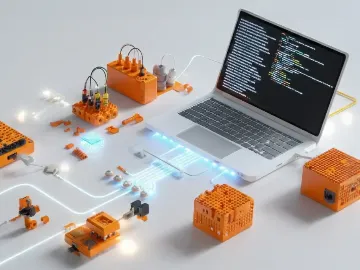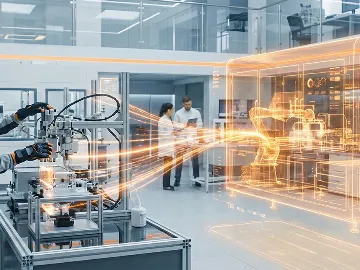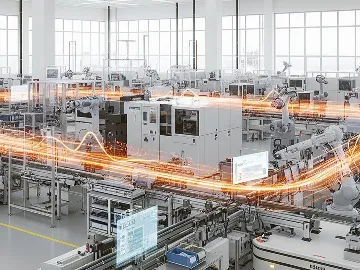Integrating AI with the Internet of Things is becoming popular among businesses that want to benefit from data generated by IoT devices. However, with the growing cloud storage cost, companies are considering adopting on-device AI, i.e., moving AI and Machine Learning (ML) onto the devices.
This article explains how this technology works, what businesses may benefit from it, as well as what use cases and applications you can already see in real-world settings.
What is on-device AI and how does it work?
On-device AI operates by deploying AI models directly onto smartphones, wearables, edge computing devices, or other IoT devices. These gadgets should be equipped with hardware components to help AI algorithms run efficiently without relying on a constant Internet connection or cloud data processing.
The AI models are trained using Machine Learning (ML) on large datasets and then deployed onto the devices' onboard memory. Once deployed, these models can analyze sensor data, images, audio, and other inputs locally, enabling devices to perform image and speech recognition, predictive maintenance, and more. Connected with other AI-powered IoT devices, they form AIoT systems capable of processing large data sets and using information for further inference and data-driven decisions.
Unlike traditional AI systems that process data in centralized cloud-based servers, device-based AI brings intelligence closer to the data source, empowering devices to independently make real-time decisions and actions. By leveraging onboard processors and memory, on-device artificial intelligence enhances applications' speed, efficiency, and privacy. However, these are just a few advantages of moving AI onto the device. Let's explore more.
Benefits of on-device AI
The adoption of this tech offers numerous advantages for businesses across various industries.
- In automotive, this type of AI enables real-time processing needed for autonomous vehicles.
- In healthcare, it allows wearables to perform their functions without connectivity, extending healthcare services to areas with unstable Internet connection.
- In retail, on-device AI is used for smart mirrors and interactive displays, allowing customized shopping experiences.
- In agriculture, it can be used in drones and robots that monitor the condition of crops and soil. It allows immediate intervention in the case of crop disease, leading to better resource management and harvest.
- In a smart home, the approach can be used in smart appliances like security cameras, thermostats, utilities, smart speakers and remote controls to personalize the use of the gadgets, improve accessibility, and dynamically respond to the changes in the environment (e.g., lowering temperature in rooms with low occupancy, sending alarm notifications in case of potential threats).
Other industries that use IoT devices and need to power them with AI capabilities will also benefit from moving artificial intelligence closer to the device. Here are a few examples of such benefits.

Real-time processing
On-device AI enables real-time data processing and direct decision-making on the device without constant internet connectivity or reliance on cloud servers. For example, this approach allows autonomous vehicles to respond immediately based on real-time data from sensors such as cameras, LiDAR, and radar. It helps the machines quickly assess their surroundings and adjust to road conditions, traffic situations, and unexpected obstacles.
Enhanced privacy and security
Cybersecurity concerns are why organizations are reluctant to innovate and adopt new technologies and IoT tools that require connection to the cloud, however useful they would have been for the organization.
And these reasons are valid, as the number of cyberattacks involving IoT devices showed exponential increase: from 34.3M in 2019 to 112M in 2022, according to Statista. This trend will persist, as over 90% of IoT security cameras have some security vulnerability, says Gartner's analyst Tim Zimmerman.

On-device AI enhances data privacy by minimizing data transmission of sensitive content to external servers for processing. For instance, in finance, on-device AI can analyze financial transactions securely on the user's device, reducing the risk of exposing sensitive data. This approach mitigates security risks associated with data transmission and ensures compliance with data protection regulations such as GDPR and ISO.
Available offline functionality
With AI models running on physical devices, applications can function even in offline or low-connectivity environments, ensuring uninterrupted operation and user experience. This capability is valuable for mobile apps, IoT devices, and remote or rural areas where internet access may be unreliable.
For example, in agriculture, on-device AI can analyze soil and weather data locally on farming equipment, allowing farmers to make informed decisions even when operating in areas with poor network coverage.
Lower data transfer costs and bandwidth use
By reducing reliance on cloud infrastructure for AI processing, device-based AI can lower operational costs associated with data transfer, server maintenance, and cloud service subscriptions. This is especially beneficial when bandwidth is limited or expensive.
In manufacturing, for example, on-device AI can analyze sensor data on production equipment to detect anomalies and optimize processes without requiring non-stop data transmission to a central server.
Enhanced personalization and user experience
Applications powered by on-device AI deliver faster response times and seamless functionality, leading to higher user satisfaction and engagement. The algorithms can understand the user's context and environment with the data from sensors, cameras, and other built-in components. This allows applications to dynamically adapt their behavior based on location, activity, and user preferences, providing more relevant experiences.
For instance, on-device AI can analyze user behavior and preferences in retail to provide personalized product recommendations directly within a mobile shopping app. In the case of on-device generative AI, the solution can tailor models and responses to individual users' speech patterns, expressions, behaviors, and external data (e.g., from fitness trackers). This customization creates unique user digital personas and enables tailored responses for groups or organizations.
This alone can't provide all these benefits, as a combination of technologies is required to achieve them. Let's discuss the most common ones.
Explore the AI landscape of 2026—get the guide with top trends!


Success!

Technologies commonly used with on-device AI
On-device AI requires powerful hardware to run its algorithms on the edge. However, it should also work with other technologies that ensure data collection and preprocessing. Here are the most popular ones.

Internet of Things
In on-device AI, IoT devices play a crucial role in collecting data from sensors embedded in the environment, enabling real-time monitoring and analysis. These devices utilize sensor fusion techniques to integrate data from multiple sensors, allowing for a comprehensive analysis of the surroundings.
Powered with AI, IoT devices can autonomously detect anomalies, make decisions locally, and operate efficiently without constant reliance on centralized servers. The integration of IoT and AI that runs on a physical device enhances the intelligence and autonomy of edge devices, leading to more efficient and effective IoT deployments across industries.
Machine Learning
Machine Learning (ML) frameworks like TensorFlow Lite, PyTorch Mobile, and Core ML enable developers to deploy ML models directly onto devices, allowing for real-time inference and on-device processing.
In addition, on-device AI requires Natural Language Processing (NLP) libraries such as NLTK, SpaCy, and Hugging Face Transformers. They enable on-device AI applications to understand and process natural language inputs, enabling features like voice recognition and language translation.
Read on: Machine Learning consulting: From a concept to measurable business value
Computer vision
Computer vision (CV) libraries like OpenCV and TensorFlow.js enable on-device AI applications to analyze and interpret visual data obtained from the cameras. CV facilitates object detection, image, facial, and gesture recognition tasks.
For example, smartphones with facial recognition technology can unlock the device or authorize payments securely using the device owner's face as a biometric identifier.
Edge computing
Edge computing platforms provide computational resources closer to the data source, reducing latency and enabling faster decision-making. AWS IoT Greengrass and Azure IoT Edge support device-based AI by deploying ML models directly on edge devices.
For example, a smart home automation system with on-device AI and edge computing capabilities can analyze sensor data locally to detect patterns or anomalies and trigger automated actions, such as adjusting thermostats or turning off lights, without overloading the home network.
Read more: Edge computing AI: Bringing real-time intelligence to connected devices
Cloud
While in cloud-based AI, the computation is performed in the cloud, on-device AI uses the cloud as a source to send and store the processed results. For instance, a traffic monitoring camera with built-in AI only transmits the license plate numbers of vehicles breaking traffic rules to the platform, rather than sending the entire day's worth of traffic video recordings.
5G
5G networks provide faster data speeds and decrease latency, allowing IoT devices to send and receive data instantly. This is ideal for applications requiring rapid decision-making, such as autonomous vehicles, healthcare monitoring devices, and industrial sensors. With 5G connectivity, on-device AI can leverage the network's capabilities to enhance performance and responsiveness, improving AI-powered devices' overall efficiency and effectiveness.
This list may feature other technologies that enable AI on devices for your project. Let's explore what tasks and use cases will require moving AI closer to the device.
On-device AI use cases
On-device AI is used across industries, optimizing how businesses operate and interact with their environments. Here are some of the most common use cases for this technology.
- Object detection and recognition. This technology enables devices to detect and recognize objects in real-time, facilitating applications such as autonomous driving, surveillance, and augmented reality.
- Virtual chatbots. On-device AI models power voice assistants and chatbots, enabling natural language understanding and interaction on smartphones, smart speakers, and other devices.
- Predictive maintenance. The technology helps analyze sensor data to predict equipment failures and maintenance needs in industrial machinery. It reduces downtime and improves asset management.
- Personalization. Device-based AI provides personalized suggestions based on user behavior, preferences, and historical data. It enhances user experience in e-commerce, media, and entertainment solutions.
These tasks are common in the entertainment, manufacturing, automotive, supply chain, logistics, and other industries. Let's review a few applications of on-device AI.
Looking for a tech partner? Here are the top 20 IoT software development companies!
On-device AI applications
Moving AI onto the edge device is already used across industries. Here are a few examples where it makes business sense.

On-device video processing
Camera monitoring or live streaming requires fast data processing and sending data in real-time with no delays to ensure customer satisfaction. For this, businesses equip their hardware (or buy new) with components capable of handling complex computations efficiently.
This hardware may include specialized processors such as GPUs or Tensor processing units (TPUs) optimized for AI tasks. Additionally, high-performance CPUs and sufficient random-access memory (RAM) are essential for handling the computational load associated with video processing tasks.
Some mobile devices and embedded systems also incorporate AI accelerators or NPUs to enhance the performance of on-device AI applications like video processing.
Real-time fall detection
Geriatric care facilities and hospitals require constant premise monitoring to ensure the residents' well-being. Surveillance cameras with built-in AI and IoT wearables can inform the caregivers about the patients' abnormal position, heart rate, and breathing so they can locate the patient and provide the needed care faster. In situations such as cardiac arrest or heart attack, quicker detection significantly improves the individual's chances of survival.
Real-time language translation
With on-device AI, smartphones can instantly translate offline, simplifying communication in foreign languages during travel or in areas with limited internet access. It is handy for leisure and professional traveling, such as journalist field trips or business meetings.
Autonomous driving and driver monitoring
AI that runs on devices plays a vital role in analyzing sensor data in real-time, crucial for ensuring safe autonomous driving. It involves detecting obstacles, planning and changing routes based on the environment, and making decisions in challenging driving conditions.
Additionally, built-in driver monitoring systems can identify signs of driver fatigue or distraction and send alerts. Moreover, it can switch to autopilot and control the vehicle when the driver isn't responding to alerts.
Read more: Define the future of your business with expertise-driven IoT consulting
When should companies switch to on-device AI?
Moving AI from the cloud onto the devices requires many resources, infrastructure changes, and expert input. However, there are a few reasons why the business may want to undergo such a transformation:
- The latency causes performance issues or harms customer experience.
- Cloud costs and bandwidth requirements are increasing.
- Your solutions require real-time AI input regardless of the Internet availability (e.g., autonomous vehicles, real-time health monitoring)
These scenarios are just a few of many that exemplify the usefulness of this technology. When you decide to give it a try, there are a few things to keep in mind.
Explore the topic: Key IoT security issues and how to tackle them
What should you know about adopting AI on devices?
While AI technology on devices has much potential, it also has some limitations you should know before starting the project. Here's what you should consider before deciding.
- On-device AI requires powerful hardware. Since the AI models run on the device, it should have enough computing capabilities to allow processing. Depending on the models you want to use, you will need to either upgrade your hardware or buy a new one.
- Scalability may be out of the question. You can scale your capabilities in cloud-based AI by buying more cloud computing storage and tools. However, on-device AI potential is limited by the hardware on which it is performed. It means you will need to upgrade the hardware every time your project needs scaling.
- You should be aware of AI regulations. Adopting AI on implanted healthcare devices can positively affect their performance and expand their possibilities. However, the adoption of this technology is strictly regulated. Moreover, AI unpredictability can be a major factor in why the authorities won't approve the device and, consequently, its market entrance.
- The tech partner's expertise in the related technologies is key. Except for AI and ML, the team developing or integrating AI on devices should also have expertise in IoT, computer vision, edge computing, sensor fusion, 5G, and cloud computing to suggest the most optimal solution for your business. Their experience within your industry would be a huge advantage as they know industry trends, customer preferences, and the best tools to use.
With over 23 years of partnering with the world's leading enterprises, N-iX has gained valuable experience designing, developing, implementing, and consulting on solutions for various industries. Here are a few other things that make N-iX a reliable tech company for leading your on-device AI project.
N-iX can help you adopt AI on devices
At N-iX, we specialize in designing, developing, and deploying on-device AI solutions tailored to our clients' specific requirements and objectives.
Our team of experienced AI engineers, data scientists, and software developers leverages technologies and best practices to deliver innovative on-device AI applications across finance, manufacturing, logistics and supply chain, retail, telecom, automotive, healthcare, energy, and agritech sectors. We have over 160 active tech projects supporting businesses' growth in Europe and the Americas.
Our engineers are skilled in key technologies for on-device AI, like Big Data, Machine Learning, data analytics, computer vision, generative AI, robotic process automation (RPA), embedded systems, and cybersecurity. Contact us to discuss how we can apply our knowledge and expertise to your on-device AI project and ensure its adoption will benefit your business outcomes!
Have a question?
Speak to an expert




